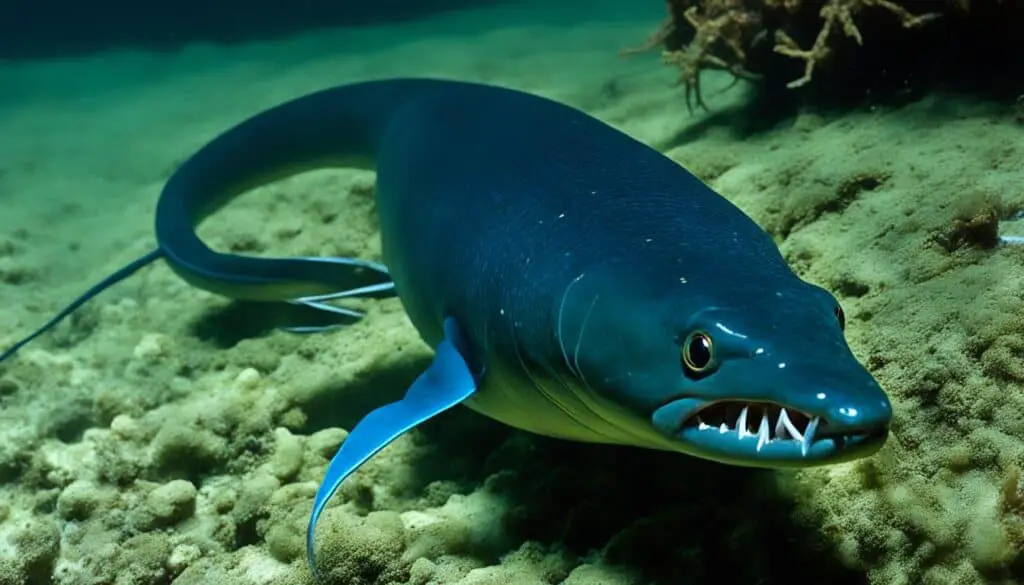Exploring the world of electric eels brings up an important question: Are they dangerous to humans? These creatures can create powerful electrical discharges. This raises questions about their safety and the risks of meeting them. While it’s true that serious injuries or even death can happen, such cases are quite rare.
It’s key to know how they behave, how they make electricity, and how to stay safe around them. This knowledge is vital for anyone curious about these unique water animals.
Understanding Electric Eels: An Overview
To understand electric eels, we need to look at their classification and where they live, as well as their looks. This gives us a peek into the amazing world of these unique fish.
Classification and Habitat
Electric eels are classified as part of the Gymnotiformes order. They are scientifically known as Electrophorus electricus. These fish live in the Amazon and Orinoco river basins in South America. They prefer murky waters and stay mostly at the bottom, coming up for air now and then.
There are three main species: Electrophorus voltai, Electrophorus varii, and Electrophorus electricus. Each lives in its own area, adapting to its environment.
Physical Characteristics
Electric eels have a unique look. They can grow up to 8 feet long and weigh as much as 44 pounds. Their bodies are long and thin, similar to true eels. They have a dark green or gray skin on top and a yellowish belly.
They have special electric organs filled with about 6,000 electrocytes. These help them make a lot of electricity. Amazingly, only 20% of their body is vital organs, while 80% is electric organs.
| Characteristic | Description |
|---|---|
| Species Classification | *Electrophorus electricus*, *Electrophorus voltai*, *Electrophorus varii* |
| Length | Up to 8 feet |
| Weight | Up to 44 pounds |
| Body Shape | Cylindrical and elongated |
| Color | Dark green or grayish with a yellowish underbelly |
| Electric Organs | Approximately 6,000 electrocytes |
| Vital Organs | 20% of body length |
| Electric Organ Length | 80% of body length |
How Electric Eels Generate Electricity
Electric eels have a unique way of making electricity. They use special cells called electrocytes. These cells work like tiny batteries, letting the eel create a lot of electrical energy.
When the eel’s nervous system tells these cells to work together, they release electricity at the same time. This creates a strong electrical shock. Some electric eels can produce up to 860 volts.
The Role of Electrocytes
Electrocytes are key to how electric eels make their electricity. Each cell can store and release electricity on command. When they all release together, they make a strong electric shock.
This shock can stop prey in its tracks or keep predators away. It shows how electric eels have evolved to survive.
Types of Electric Discharges
Electric eels have three main ways to use electricity. The first type is for finding their way and spotting prey. It uses low voltage.
The second type is for catching prey. It’s a short, high-voltage shock. The third type is for defense, a strong burst to scare off threats. Knowing about these discharges helps us understand electric eels better.
Are Electric Eels Dangerous to Humans?
It’s key to know the risks of electric eel encounters if you’re near their waters. These creatures are interesting but can be dangerous. Their electric shocks can knock people out, leading to serious harm or death.
Potential Risks of Electric Shocks
The electric eels danger is clear in shallow waters. A shock can make someone unable to swim, increasing drowning risk. Shock severity can vary, but repeated shocks can cause breathing or heart problems, showing the real dangers.
Documented Cases of Injury and Death
There are many documented cases of electric eel injuries that show their threats. Fatalities are rare but happen, often from drowning after being shocked and unable to move. Stories of fishermen encountering electric eels highlight the need for caution in their habitats.
Electric Eel Behavior and Interaction with Humans
Electric eels show unique behaviors that highlight their survival skills. They are both hunters and defenders. Their hunting and defense tactics are quite interesting.
Predatory Strategies
Electric eels use their electric power to catch prey. They stun fish and small animals with electric shocks. This helps them hunt in murky waters.
They also have other hunting methods:
- Employ powerful electric discharges to stun fish and other small animals.
- Leap from the water to surprise prey, showcasing agility and precision.
- Curl around larger prey, maximizing the shock they deliver for an effective kill.
Responses to Threats
Electric eels also have ways to defend themselves. When they feel threatened, they can:
- Deliver strong electric shocks to deter attackers.
- Use agility to leap and attack from above, maintaining an advantageous position.
- Rely on a highly developed sensory system to detect and react swiftly to potential threats.

Electric Eels: Myths and Facts
Electric eels often catch our attention because of the many myths around them. These myths can make people misunderstand their true nature and abilities. For example, many think electric eels are deadly. But, they can shock, but most shocks are not deadly.
Common Misconceptions
There are many myths about electric eels, mainly because of their name and special abilities. Here are some of the most common myths:
- Electric eels are not real eels. They belong to the knifefish family.
- They are not purely lethal creatures despite their powerful shocks.
- Electric eels can generate voltage outputs much higher than the average household circuit.
Interesting Facts About Electric Eels
There are also some fascinating facts about electric eels that can help us understand them better:
- Electric eels can produce enough electricity to power small devices, showing their amazing electrical skills.
- These creatures live in complex social groups, showing behaviors like parental care, guarding their nests of eggs.
- Electric eels use electrocytes to make their unique electric discharges. This helps them navigate and communicate.
Safety Precautions Around Electric Eels
When you’re near electric eels, you need to be careful to stay safe. If you fish in places where these eels live, follow some important steps. Use insulated gear to avoid getting shocked. Also, try not to fish during twilight hours when eels are most active.
Always have a fishing buddy to keep an eye out for any dangers. This way, you can react fast if you meet an electric eel.
When Fishing in Electric Eel Habitats
Knowing where electric eels live can help keep you safe. Watch your surroundings and look for signs of these eels. It’s wise to avoid fishing in murky waters because you can’t see what’s there.
Swimming Safety Tips
If you swim where electric eels might be, be extra careful. Don’t swim in places you don’t know well, especially at sunset when eels are most active. Always swim with a friend to stay safe.
Be on the lookout for any sudden electrical discharges in the water. This could mean an electric eel is close by.
FAQ
Are electric eels dangerous to humans?
Yes, electric eels can be dangerous because they can give powerful electric shocks. These shocks are rare but can knock a person out, leading to drowning or serious injuries.
What should I know about electric eel safety?
To stay safe around electric eels, don’t swim in murky waters, especially at dawn or dusk. When fishing where they live, use insulated gear and have a partner to help avoid risks.
What are the risks of electric eel encounters?
The risks include getting knocked out by electric shocks, which can cause drowning or heart failure. Knowing where they live and how they act can help avoid unexpected meetings.
How do electric eels generate electricity?
Electric eels make electricity with special cells called electrocytes. When these cells work together, they release a strong electric shock.
What types of electric discharges do electric eels use?
Electric eels use three kinds of electric discharges. They send out low-voltage pulses to navigate, short high-voltage bursts to stun prey, and high-intensity bursts for defense.
Are there documented cases of injury and death from electric eels?
Yes, there are cases where electric eel shocks have caused serious injuries and even death. This is often because the shock made the person drown.
What are some predatory strategies of electric eels?
Electric eels stun their prey with electric discharges before eating it. They can jump out of the water to attack and curl around big prey to make their shocks more effective.
How do electric eels respond to threats?
When threatened, electric eels give off strong electric shocks to scare off predators. They have a sharp sense system that helps them detect and react to threats.
What are some common misconceptions about electric eels?
Some think electric eels are always deadly, but serious encounters are rare. They are not true eels but are part of the knifefish family.
What interesting facts should I know about electric eels?
Electric eels can make a lot more voltage than what’s in your house. They also take care of their young, with males guarding the eggs until they hatch.
What safety precautions should I take when fishing in electric eel habitats?
When fishing for electric eels, use insulated gear and don’t fish during their active times (dawn and dusk). Always have a partner to ensure your safety.
What swimming safety tips should I consider around electric eels?
Swim with a buddy in places where electric eels might be, avoid murky waters, and watch your surroundings for any sudden electric discharges.







